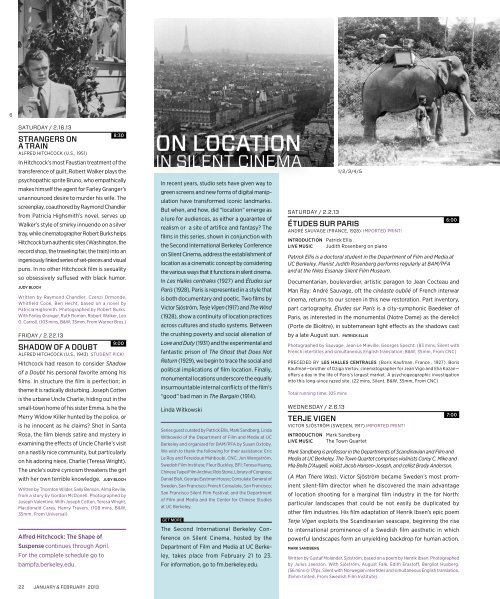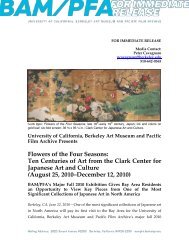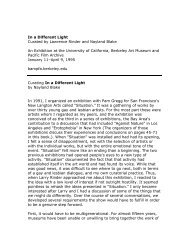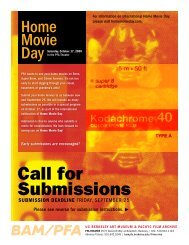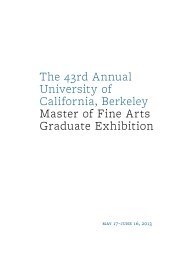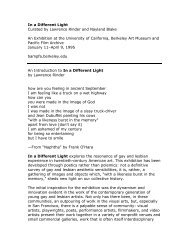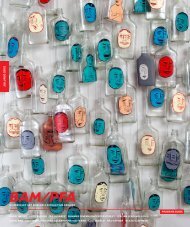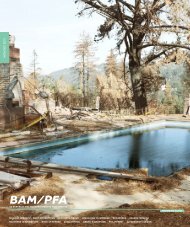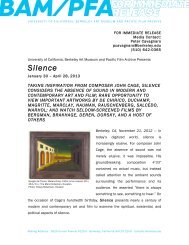January & February 2013 - Berkeley Art Museum and Pacific Film ...
January & February 2013 - Berkeley Art Museum and Pacific Film ...
January & February 2013 - Berkeley Art Museum and Pacific Film ...
- No tags were found...
Create successful ePaper yourself
Turn your PDF publications into a flip-book with our unique Google optimized e-Paper software.
6Saturday / 2.16.13Strangers ona TrainAlfred Hitchcock (U.S., 1951)8:30In Hitchcock’s most Faustian treatment of thetransference of guilt, Robert Walker plays thepsychopathic sprite Bruno, who empathicallymakes himself the agent for Farley Granger’sunannounced desire to murder his wife. Thescreenplay, coauthored by Raymond Ch<strong>and</strong>lerfrom Patricia Highsmith’s novel, serves upWalker’s style of smirky innuendo on a silvertray, while cinematographer Robert Burks helpsHitchcock turn authentic sites (Washington, therecord shop, the traveling fair, the train) into aningeniously linked series of set-pieces <strong>and</strong> visualpuns. In no other Hitchcock film is sexualityso obsessively suffused with black humor.Judy BlochWritten by Raymond Ch<strong>and</strong>ler, Czenzi Ormonde,Whitfield Cook, Ben Hecht, based on a novel byPatricia Highsmith. Photographed by Robert Burks.With Farley Granger, Ruth Roman, Robert Walker, LeoG. Carroll. (103 mins, B&W, 35mm, From Warner Bros.)Friday / 2.22.139:00Shadow of a DoubtAlfred Hitchcock (U.S., 1943) student pick!Hitchcock had reason to consider Shadowof a Doubt his personal favorite among hisfilms. In structure the film is perfection; intheme it is radically disturbing. Joseph Cottenis the urbane Uncle Charlie, hiding out in thesmall-town home of his sister Emma. Is he theMerry Widow Killer hunted by the police, oris he innocent as he claims? Shot in SantaRosa, the film blends satire <strong>and</strong> mystery inexamining the effects of Uncle Charlie’s visiton a nastily nice community, but particularlyon his adoring niece, Charlie (Teresa Wright).The uncle’s outré cynicism threatens the girlwith her own terrible knowledge. Judy BlochWritten by Thornton Wilder, Sally Benson, Alma Reville,from a story by Gordon McDonell. Photographed byJoseph Valentine. With Joseph Cotten, Teresa Wright,Macdonald Carey, Henry Travers. (108 mins, B&W,35mm, From Universal)Alfred Hitchcock: The Shape ofSuspense continues through April.For the complete schedule go tobampfa.berkeley.edu.On Locationin Silent CinemaIn recent years, studio sets have given way togreen screens <strong>and</strong> new forms of digital manipulationhave transformed iconic l<strong>and</strong>marks.But when, <strong>and</strong> how, did “location” emerge asa lure for audiences, as either a guarantee ofrealism or a site of artifice <strong>and</strong> fantasy? Thefilms in this series, shown in conjunction withthe Second International <strong>Berkeley</strong> Conferenceon Silent Cinema, address the establishment oflocation as a cinematic concept by consideringthe various ways that it functions in silent cinema.In Les Halles centrales (1927) <strong>and</strong> Études surParis (1928), Paris is represented in a style thatis both documentary <strong>and</strong> poetic. Two films byVictor Sjöström, Terje Vigen (1917) <strong>and</strong> The Wind(1928), show a continuity of location practicesacross cultures <strong>and</strong> studio systems. Betweenthe crushing poverty <strong>and</strong> social alienation ofLove <strong>and</strong> Duty (1931) <strong>and</strong> the experimental <strong>and</strong>fantastic prison of The Ghost that Does NotReturn (1929), we begin to trace the social <strong>and</strong>political implications of film location. Finally,monumental locations underscore the equallyinsurmountable internal conflicts of the film’s“good” bad man in The Bargain (1914).Linda WitkowskiSeries guest curated by Patrick Ellis, Mark S<strong>and</strong>berg, LindaWitkowski of the Department of <strong>Film</strong> <strong>and</strong> Media at UC<strong>Berkeley</strong> <strong>and</strong> organized for BAM/PFA by Susan Oxtoby.We wish to thank the following for their assistance: EricLe Roy <strong>and</strong> Fereidoun Mahboubi, CNC; Jon Wengström,Swedish <strong>Film</strong> Institute; Fleur Buckley, BFI; Teresa Huang,Chinese Taipei <strong>Film</strong> Archive; Rob Stone, Library of Congress;Daniel Bish, George Eastman House; Consulate General ofSweden, San Francisco; French Consulate, San Francisco;San Francisco Silent <strong>Film</strong> Festival; <strong>and</strong> the Departmentof <strong>Film</strong> <strong>and</strong> Media <strong>and</strong> the Center for Chinese Studiesat UC <strong>Berkeley</strong>.Get MoreThe Second International <strong>Berkeley</strong> Conferenceon Silent Cinema, hosted by theDepartment of <strong>Film</strong> <strong>and</strong> Media at UC <strong>Berkeley</strong>,takes place from <strong>February</strong> 21 to 23.For information, go to fm.berkeley.edu.Saturday / 2.2.13Études sur ParisAndré Sauvage (France, 1928) Imported Print!Introduction Patrick EllisLive Music Judith Rosenberg on pianoPatrick Ellis is a doctoral student in the Department of <strong>Film</strong> <strong>and</strong> Media atUC <strong>Berkeley</strong>. Pianist Judith Rosenberg performs regularly at BAM/PFA<strong>and</strong> at the Niles Essanay Silent <strong>Film</strong> <strong>Museum</strong>.6:00Documentarian, boulevardier, artistic paragon to Jean Cocteau <strong>and</strong>Man Ray: André Sauvage, oft the cinéaste oublié of French interwarcinema, returns to our screen in this new restoration. Part inventory,part cartography, Études sur Paris is a city-symphonic Baedeker ofParis, as interested in the monumental (Notre Dame) as the derelict(Porte de Bicêtre), in subterranean light effects as the shadows castby a late August sun. Patrick EllisPhotographed by Sauvage, Jean Le Miéville, Georges Specht. (83 mins, Silent withFrench intertitles <strong>and</strong> simultaneous English translation, B&W, 35mm, From CNC)Preceded by Les Halles centrales (Boris Kaufman, France , 1927). BorisKaufman—brother of Dziga Vertov, cinematographer for Jean Vigo <strong>and</strong> Elia Kazan—offers a day in the life of Paris’s largest market. A psychogeographic investigationinto this long-since razed site. (22 mins, Silent, B&W, 35mm, From CNC)Total running time: 105 minsWednesday / 2.6.13Terje VigenVictor Sjöström (Sweden, 1917) Imported Print!7:00Introduction Mark S<strong>and</strong>bergLive Music The Town QuartetMark S<strong>and</strong>berg is professor in the Departments of Sc<strong>and</strong>inavian <strong>and</strong> <strong>Film</strong> <strong>and</strong>Media at UC <strong>Berkeley</strong>. The Town Quartet comprises violinists Corey C. Mike <strong>and</strong>Mia Bella D’Augelli, violist Jacob Hansen-Joseph, <strong>and</strong> cellist Brady Anderson.(A Man There Was). Victor Sjöström became Sweden’s most prominentsilent-film director when he discovered the main advantageof location shooting for a marginal film industry in the far North:particular l<strong>and</strong>scapes that could be not easily be duplicated byother film industries. His film adaptation of Henrik Ibsen’s epic poemTerje Vigen exploits the Sc<strong>and</strong>inavian seascape, beginning the riseto international prominence of a Swedish film aesthetic in whichpowerful l<strong>and</strong>scapes form an unyielding backdrop for human action.Mark S<strong>and</strong>berg1/2/3/4/5Written by Gustaf Mol<strong>and</strong>er, Sjöström, based on a poem by Henrik Ibsen. Photographedby Julius Jaenzon. With Sjöström, August Falk, Edith Erastoff, Bergliot Husberg.(56 mins @ 17fps, Silent with Norwegian intertitles <strong>and</strong> simultaneous English translation,35mm tinted, From Swedish <strong>Film</strong> Institute).22 january & FEBRuary <strong>2013</strong>


